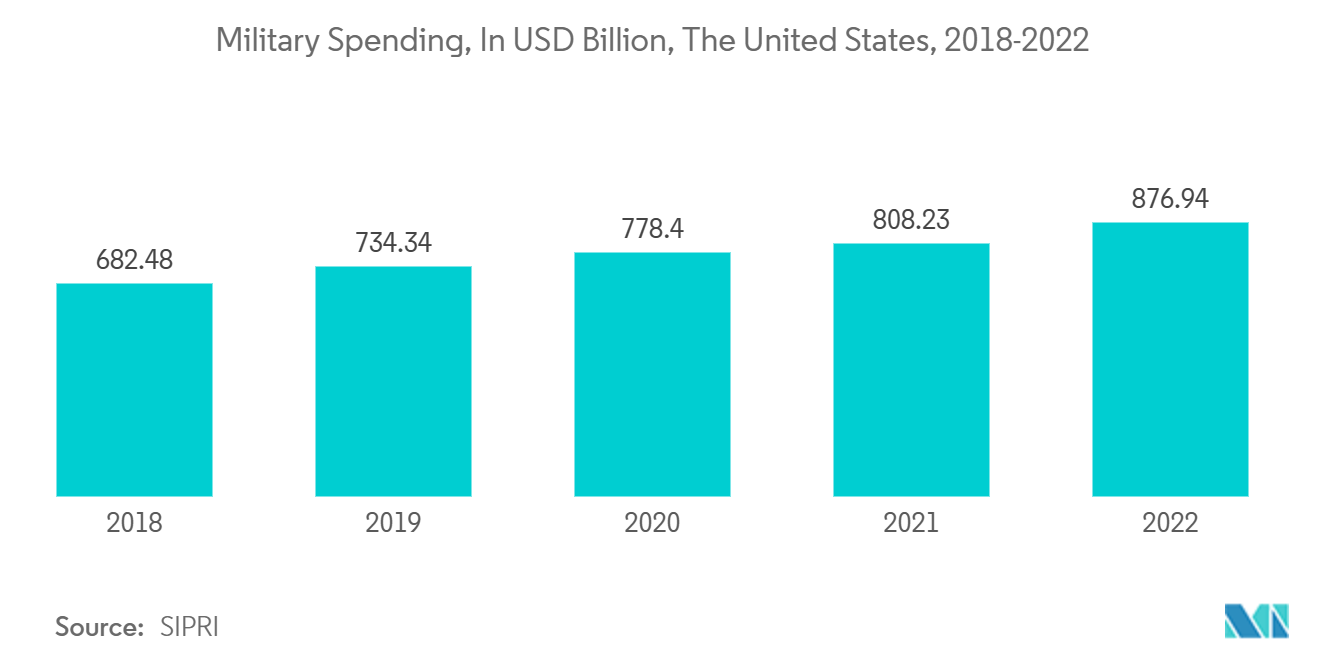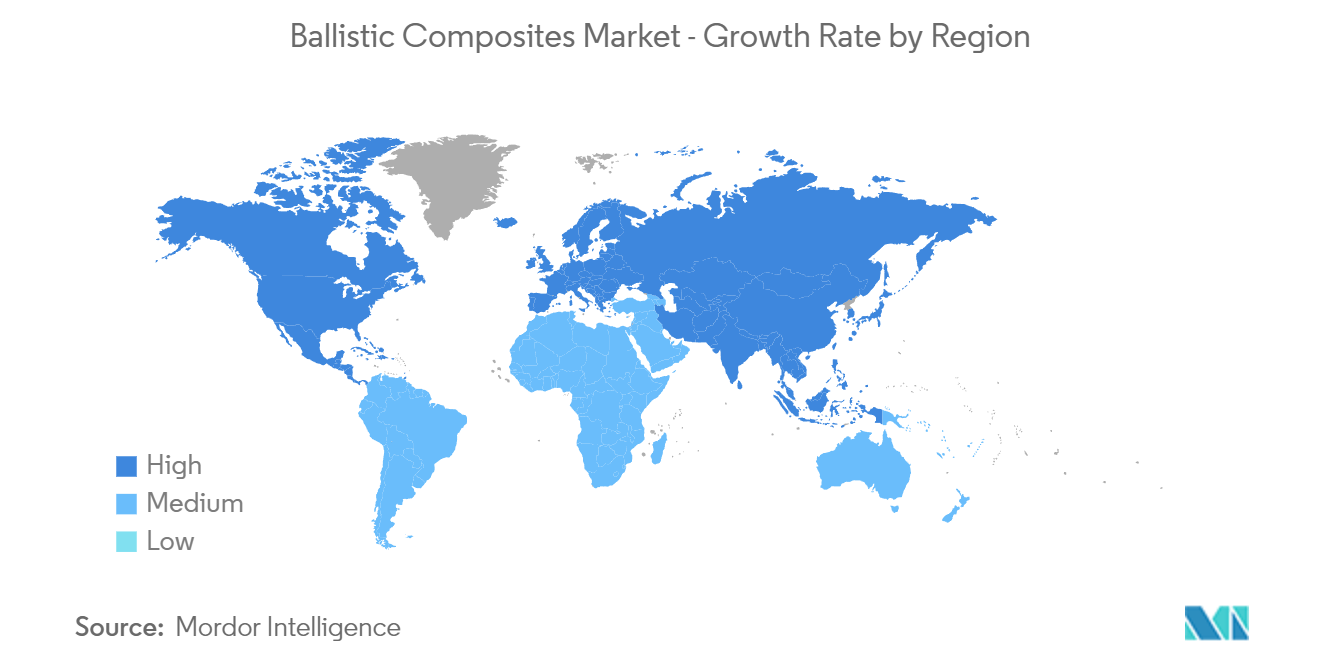Market Trends of Ballistic Composites Industry
Increasing Demand for Vehicle Armors
- The demand for vehicle armor in the ballistic composites market is definitely on the rise. It is driven by a multitude of factors, such as growing security concerns, technological advancements, expanding applications, and many more.
- Armored personnel carriers, combat vehicles, and even some military trucks are increasingly utilizing ballistic composites for protection.
- Land combat vehicles are protected by armor sufficient to withstand heavy machinegun fire and overhead artillery fire. These vehicles include external armor kits, which include glass fiber-reinforced support plates. A strengthened undercarriage protects the personnel inside from mines. Exterior armor design generally includes modular expandable armor system panels made with ceramic-faced woven aramid. The roof interiors consist of molded-woven aramid reinforced composites, and the interior sides contain molded, S-fiberglass-reinforced composites.
- Armor protection against ground fire from small arms is also required on the bottom of helicopters. As the fuselage of helicopters needs to be light, the base portion is generally vulnerable to small-arms fire from the ground. It puts the occupants at risk. Lightweight armor for the bottom of helicopters is in use for many years.
- Increasing warfare across the world is increasing the demand for military vehicles required in warships, which is likely to increase the demand for vehicle armor during the forecast period.
- Increased defense spending and security budgets are leading to more significant investment in armored vehicles and advanced armor technologies.
- China's defense industry is increasing, with many Chinese firms displacing Western defense powerhouses. The country invests heavily to upgrade its military, thus making its eight defense firms among the top 25 in the world.
- Currently, the annual output of Chinese military aircraft is around 300. As China's military industry continues to grow, the demand for and supply of Chinese military aircraft will increase substantially. It will drive the rapid development of China's military aircraft manufacturing industry.
- In June 2021, Indonesia unveiled another plan to spend USD 125 billion through the mid-2040s to upgrade and modernize its military arsenal. The total period runs through a period of five strategic plans, each lasting five years. The first strategic plan runs from 2020 to 2024 and coincides with the final phase of the Minimum Essential Force (MEF) program. The document proposes funding of USD 79 billion for defense equipment during these 25 years, USD 32.5 billion for sustainment, and the remaining USD 13.4 billion for interest payments on foreign loans.
- In Japan, an increase in defense expenditure, rising procurement of next-generation weapons, and adoption of advanced technologies in military communication drive the growth of the market across Japan. According to the report published by the Stockholm International Peace Research Institute (SIPRI) in 2022, Japan was the tenth largest defense spender in the world, with a defense budget of USD 46 billion. The country approved USD 51.4 billion in defense spending in FY2023.
- Composite materials gradually crept into armor systems for naval vessels and land combat vehicles. They displaced steel, aluminum, and even titanium alloys, partly due to improved ballistic efficiencies similar to the significant advancements in specific strength and stiffness made in structural materials, as well as being lightweight. Composite parts can be part of the primary armor, especially effective against fragmentation, originating from grenades, mortars, artillery, and other explosive devices. Vehicles can use armor laminates of either S-glass or Kevlar fabric.
- In the area of vehicle armor, ballistic composites provided the following benefits: reduced the weight of a vehicle, increased mobility, decreased number of components required to armor, increased fuel efficiency, and increased life of the vehicle.

North American Region to Dominate the Market
- The North American region dominated the global market share due to the growing aerospace and defense industrial activities and the increasing need to bring down costs, lower carbon dioxide emissions, and reduce fuel consumption.
- The United States is the largest consumer of the market studied. For FY 2022, the Department of Defense's (DoD) budget authority is approximately USD 722 billion, an increase of USD 17 billion from USD 705 billion in 2020. In comparison, the FY 2023 President's budget request was USD 773 billion for the DoD. The budget primarily aims to modernize capabilities in the air, maritime, and land warfighting domains and to innovate to strengthen the country's competitive advantage.
- By 2023, the Navy forces may increase by 16,900, the Marine Corps by 1,400, and the Air Force by 13,700, increasing the total active-duty military to 1,365,500 personnel.
- The proposal also includes an investment of USD 6.5 billion to place more tanks, armored vehicles, and other combat equipment in Europe as part of the Pentagon plan to reassure European allies.
- As of October 2022, the US Army and BAE Systems are working together to identify ways to accelerate production of the new Armored Multi-Purpose Vehicle, which would let the service more quickly replace aging M113 armored troop carriers.
- According to the Congressional Research Service, the AMPV(Armored Multi-Purpose Vehicle) annual production rate reportedly, by FY2024, AMPV production rates are planned to increase to 131 vehicles per year and to continue at that level until at least FY2027. Earlier AMPV program planning documents issued before the 2020 production delay had reportedly called for an annual production rate of 190 AMPVs per year by FY2024.
- The country's defense agencies are on a spree of procurements in view of the Russia-Ukraine war that drove significant US weapon supply to Ukraine. To successfully tackle any Russian threat, the Air Force is carrying out growth in procurement. For instance:
- Recently, in March 2022, the Pentagon requested a USD 11 billion fund for 61 Lockheed Martin F-35 Lightning II aircraft for FY2023. About 45% of that procurement plan is for combat aircraft (USD 8.389 billion) and 23% for modifying in-service platforms (USD 4.257 billion).
- Owing to the factors above, the ballistic composites market in the region is expected to increase at a significant rate during the forecast period.


